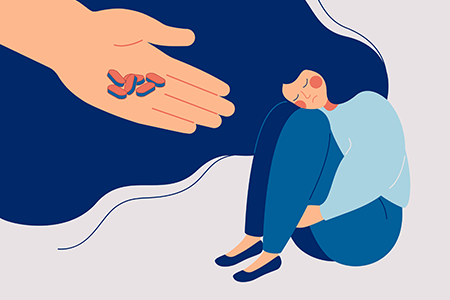
Do you have patients who are misusing opiates? Do you wonder if you can manage prescribing medications for opioid use disorder (MOUD) or have questions about what to prescribe? Drug overdose deaths in the United States are at an all-time high, with most caused by opioid use, namely fentanyl. The good news is that effective medication treatments for opioid use are available, and in case you didn’t know, Washington providers can call the Psychiatry Consultation Line at 877-927-7924 to consult with our psychiatrists about using these treatments with your adult patients.
It’s critical for more clinicians to explore whether they can prescribe MOUD; in 2019, only 18% of people with opioid use disorder (OUD) received MOUD in the prior year. What are the MOUD options for your patients living with OUD?
Methadone
The three FDA-approved MOUD options are methadone, buprenorphine and naltrexone. Methadone is a full mu-opioid agonist that has been exhaustively studied and shown to be safe and effective for patients with OUD, particularly when dosed above 60 mg per day. Because of the time involved in titration, achieving a dose of methadone that alleviates cravings and protects patients from overdose can take weeks. Despite the efficacy data, methadone is the most tightly regulated MOUD, and it is only accessible through DEA-approved treatment facilities. Many counties in Washington have no methadone clinics, leaving those with OUD only two MOUD options: naltrexone and buprenorphine.
Naltrexone
Naltrexone, particularly in the form of the 380 mg per month, long-acting injectable is another option for patients. As a full mu opioid blocker, initiation of naltrexone requires full withdrawal from opioids. Starting naltrexone prior to completion of opioid withdrawal can result in precipitated withdrawal. Many patients are unable to achieve full cessation and thus studies have shown higher dropout rates with naltrexone for OUD compared to buprenorphine.
Buprenorphine
Buprenorphine is the third FDA-approved MOUD with evidence similar to methadone in terms of treatment outcomes. In years past, prescribing buprenorphine required at least 8 hours of training and an x-waiver. As of January 2023, this requirement was dropped and anyone with a standard DEA registration number can prescribe buprenorphine. Unlike methadone, buprenorphine can be prescribed in an office-based setting, making it more accessible for patients.
As a partial agonist with a high binding affinity for the mu-opioid receptor, buprenorphine is a very safe option for OUD. Even at maximum doses, patients do not experience respiratory depression with the medication alone. Further, doses of buprenorphine, which protect patients from overdose, can be achieved quickly in one or two days. Given the pharmacologic properties of buprenorphine, patients must be in some degree of opioid withdrawal prior to initiating buprenorphine, as it can otherwise precipitate opioid withdrawal. Typically, it is recommended for patients to achieve a clinical opioid withdrawal scale (COWS) score of 8 or more prior to initiating buprenorphine. Though precipitated withdrawal is not necessarily dangerous, patients feel extremely uncomfortable and can have negative connotations with buprenorphine, reducing their likelihood of continuing the medication in the future.
Thankfully this outcome is a relatively rare occurrence. In one recent study less than 1% of patients experienced precipitated withdrawal when dosed with buprenorphine after achieving a COWS score greater than 8. Techniques for initiating buprenorphine varies significantly, ranging from “low dose induction,” the practice of giving small doses of buprenorphine with gradual increases over time to “standard induction,” giving 4 mg -12 mg of buprenorphine in the first day, to “high dose inductions” initiating higher doses of buprenorphine, 16 mg to 32 mg quickly following emergence of withdrawal symptoms.
Buprenorphine Treatment Guidelines
Regardless of the initiating dose, the goal of treatment is to achieve a dose of buprenorphine that eliminates opioid withdrawal, significantly reduces or eliminates craving to use opioids, and blocks the effects of illicit opioids to the degree that the patient has significantly reduced, or better yet, stopped use of illicit opioids all together. If patients have cravings to use, evidence of withdrawal from opioids, or continue using illicit opioids, increasing the dose of buprenorphine should be considered. The current maximum dose is 32mg daily.
Previous guidelines have suggested that doses of buprenorphine beyond 24 mg may not be necessary, but these recommendations were based primarily on data associated with patients using heroin. In the current era where the illicit opioid market is dominated by fentanyl, patients may well require higher doses of buprenorphine. Typically, buprenorphine has been dosed once daily, but for some, 2-4 doses spread throughout the day are preferred. Buprenorphine has multiple formulations for the treatment of OUD which include sublingual, buccal, implantable, and long-acting subcutaneous injectable versions.
There are no clear data on the length of time patients with OUD should remain on MOUD. However, after cessation of medications, rates of return to use of opioids is high, so most experts recommend ongoing maintenance therapy with buprenorphine or methadone. For more information on treatment of patients with MOUD, please see the resources below. And please call the PCL at 877-927-7924 if you are a Washington provider who would like to consult about your adult patients with mental health and/or substance use care needs.
Author
Jonathan Buchholz, MD
Director, Addictions Psychiatry Fellowship; Medical Director of Inpatient Psychiatry, VA Puget Sound
Dr. Buchholz specializes in working with individuals experiencing co-occurring mental health and substance use disorders, a process that reminds him of the amazing resiliency that lies within us all.
Related Resources
Practice-Based Guidelines: Buprenorphine in the Age of Fentanyl
Provides practical clinical practice-based guidance, based on available research combined with emerging clinical experience, on the use of buprenorphine in the treatment of individuals using fentanyl and other highly potent synthetic opioids.
Linking People with Opioid Use Disorder to Medication Treatment
This prevention resource presents strategies that can help state, local, and tribal leaders and healthcare professionals link persons living with OUD to evidence-based care. Strategies are based on the best available evidence.
Medications for Opioid Use Disorder
The Executive Summary of this Treatment Improvement Protocol provides an overview on the use of the three Food and Drug Administration-approved medications used to treat opioid use disorder—methadone, naltrexone, and buprenorphine—and the other strategies and services
needed to support recovery.
Providers Clinical Support System-Medications for Opioid Use Disorders
A program funded by the Substance Abuse and Mental Health Services Administration (SAMHSA) and created in response to the opioid overdose epidemic. PCSS-MOUD’s goal is to provide evidence-based practices to improve healthcare and outcomes in the prevention of those at risk and treatment for individuals with an opioid use disorder (OUD).








